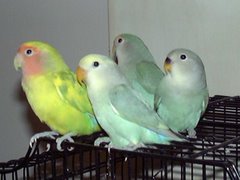Get to Know Red Faced Lovebird ( Agapornis pullaria)
Range : Sierra Leone, Cameroons, Northern Angola, Uganda and Rwanda.
Status: Variable, but believed to be abundant in certain areas of the range.
Characteristics: It is 14 cm long.
Male Red-faced lovebirds are green in color,crimpson from top of head,across cheeks to upper throat, rump blue, undertail converts black, beak red.
Female lovebirds possesses paler red head, undertail converts green. Young- brow and surrounding area yellowish; beak pale red. Young males in the nest already show black undertail converts.
After World War II, Red-faced Lovebirds were quite common and reasonably priced;
Their choice of nesting in the wild is peculiar, as they mostly prefer termite mounds or the nests of tree ants. The tree ants’ nest resembles sponges because they are constructed out of leaves, which the ants have chewed into holes. The Red-faced lovebirds dig their way into these structures or termite nests without attacked by the ants. They usually lay five to seven eggs and incubation is 20-24 days. Always provide willow or apple twigs for stripping.
General management
Red-faced lovebirds have very rarely been bred in captivity because of the peculiarity of their nest site. Peat-filled boxes or barrels, and cork blocks have all been used in captive breeding. The birds excavate a tunnel or chamber in the selected site for laying eggs. A secluded outdoor aviary may suit in the summer.
Young birds are very suitable for cages. As single birds, they grow very tame and only ever make a chirping, songbird-like noise.
They are nervous and highly-strung; so house them in a quiet situation. Colony groups in suitable aviaries are feasible. They are delicate birds and do best in slight heat (40 C) in winter.







 Free Ads For Bloggers
Free Ads For Bloggers


No comments:
Post a Comment